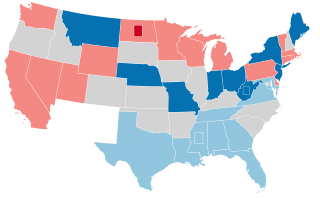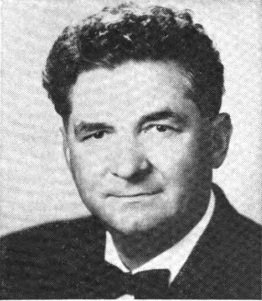
The 1948 United States Senate elections were elections which coincided with the election of Democratic President Harry S. Truman for a full term. The 32 seats of Class 2 were contested in regular elections, and one special election was held to fill a vacancy. Truman had campaigned against an "obstructionist" Congress that had blocked many of his initiatives, and in addition the U.S. economy recovered from the postwar recession of 1946–1947 by election day. Thus Truman was rewarded with a Democratic gain of nine seats in the Senate, enough to give them control of the chamber. This was the last time until 2020 that Democrats flipped a chamber of Congress in a presidential election cycle.

The 1910–11 United States Senate election were held on various dates in various states. As these U.S. Senate elections were prior to the ratification of the Seventeenth Amendment in 1913, senators were primarily chosen by state legislatures. Senators were elected over a wide range of time throughout 1910 and 1911, and a seat may have been filled months late or remained vacant due to legislative deadlock. However, some states had already begun direct elections during this time. Oregon pioneered direct election and experimented with different measures over several years until it succeeded in 1907. Soon after, Nebraska followed suit and laid the foundation for other states to adopt measures reflecting the people's will. By 1912, as many as 29 states elected senators either as nominees of their party's primary or in conjunction with a general election.

The 1926 New York state election was held on November 2, 1926, to elect the governor, the lieutenant governor, the state comptroller, the attorney general, a U.S. Senator, the chief judge and an associate judge of the New York Court of Appeals, as well as all members of the New York State Assembly and the New York State Senate. A referendum to repeal Prohibition was also proposed and accepted by a very large majority.

The 1908 New York state election was held on November 3, 1908, to elect the governor, the lieutenant governor, the Secretary of State, the state comptroller, the attorney general, the state treasurer, the state engineer and a judge of the New York Court of Appeals, as well as all members of the New York State Assembly and the New York State Senate.

The 1920 United States presidential election in Massachusetts took place on November 2, 1920, as part of the 1920 United States presidential election, which was held throughout all contemporary 48 states. Voters chose 18 representatives, or electors to the Electoral College, who voted for president and vice president.

The 1920 United States Senate election in Connecticut was held on November 2, 1920.

The 1916 United States Senate election in Maine was held on September 11, 1916.

The 1916 United States Senate election in Minnesota took place on November 7, 1916. It was the first election for either class of U.S. senators held in Minnesota after the ratification of the Seventeenth Amendment to the United States Constitution, which established the popular election of United States senators. Incumbent Senator Moses E. Clapp was defeated in the Republican primary election by former American Bar Association president Frank B. Kellogg. Kellogg went on to defeat former St. Paul Mayor Daniel W. Lawler of the Minnesota Democratic Party, and Prohibition Party challenger Willis Greenleaf Calderwood, in the general election.

The United States Senate election of 1916 in New Jersey was held on November 7, 1916.

The 1918 United States Senate election in South Dakota took place on November 5, 1918. Incumbent Republican Senator Thomas Sterling sought re-election in his first popular election. He defeated former Governor Frank M. Byrne in the Republican primary and then faced former State Representative Orville Rinehart, the 1916 Democratic nominee for Governor, in the general election. Sterling defeated Rinehart, along with independent candidate W. T. Rafferty, by a wide margin to win re-election.

The 1922 United States Senate election in Minnesota took place on November 7, 1922. Farmer–Labor challenger Henrik Shipstead defeated incumbent Republican U.S. Senator Frank B. Kellogg and Democratic challenger Anna Dickie Olesen.

The 1948 Ohio gubernatorial election was held on November 2, 1948. Democratic nominee Frank Lausche defeated incumbent Republican Thomas J. Herbert in a rematch of the 1946 election with 53.67% of the vote.

The 1920 United States presidential election in Kansas was held on November 2, 1920 as part of the 1920 United States presidential election. Kansas voters chose ten electors to the Electoral College, who voted for president and vice president.

The 1962 Arkansas gubernatorial election was held on November 6, 1962.

The 1916 Illinois gubernatorial election was held on November 7, 1916. Incumbent Democratic Governor Edward Fitzsimmons Dunne was defeated by Republican nominee Frank Orren Lowden.

The 1918 Ohio gubernatorial election was held on November 5, 1918. Incumbent Democrat James M. Cox defeated Republican nominee Frank B. Willis in their third consecutive contest with 50.62% of the vote.

The 1914 Ohio gubernatorial election was held on November 3, 1914. Republican nominee Frank B. Willis defeated incumbent Democratic Governor James M. Cox and Progressive nominee James Rudolph Garfield with 46.32% of the vote.

The 1920 Illinois gubernatorial election was held on November 2, 1920.

A general election was held in the U.S. state of Wyoming on Tuesday, November 3, 1914. All of the state's executive officers—the Governor, Secretary of State, Auditor, Treasurer, and Superintendent of Public Instruction—were up for election. Governor Joseph M. Carey declined to seek re-election to a second term, and Democratic State Senator John B. Kendrick was elected as his successor. Republicans, however, won all of the other statewide executive offices, including picking up the Superintendent's office.

A general election was held in the U.S. state of Wyoming on Tuesday, November 5, 1918. All of the state's executive officers—the Governor, Secretary of State, Auditor, Treasurer, and Superintendent of Public Instruction—were up for election. Republicans won all statewide offices by wide margins, and with Robert D. Carey's defeat of Frank L. Houx, picked up the governorship following two consecutive losses to Democrats.



















